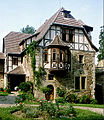
Tilman Riemenschneider was a German woodcarver and sculptor active in Würzburg from 1483. He was one of the most prolific and versatile sculptors of the transition period between the Late Gothic, to which he essentially belonged, and Northern Renaissance art, a master in limewood and stone. He was also a local politician in the council of Würzburg.

Meiningen is a town in the southern part of the state of Thuringia, Germany. It is located in the region of Franconia and has a population of around 26,000 (2024). Meiningen is the capital and the largest town of the Schmalkalden-Meiningen district. From 1680 to 1920, Meiningen was the capital of the Duchy of Saxe-Meiningen.
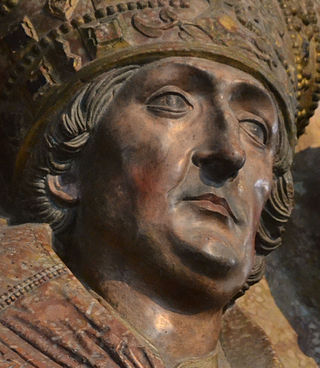
LorenzvonBibraportrait.jpg

Conrad von Bibra, Duke in Franconia (1490–1544) was Prince-Bishop of Würzburg from 1540 to 1544.

Heinrich von Bibra, Prince-Bishop, Prince-Abbot of Fulda (1711–1788) was Prince-Bishop and Prince-Abbot from 1759 to 1788. As part his role as Prince-Abbot of Fulda, he had the additional role as Archchancellor (Erzkanzler) of the Holy Roman Empress.

The House of Bibra was one of the leading Uradel families in Franconia and present day Thuringia from the mid-15th century to about 1600. Later on the family rose from Reichsritter to Reichsfreiherr. After the Holy Roman Empire dissolved, they were made ‘’Freiherr’‘ (Barons) of Bavaria and Bohemia.

Rohr is a municipality in the Schmalkalden-Meiningen district in Thuringia.

Obermaßfeld-Grimmenthal is a municipality in the district Schmalkalden-Meiningen, in Thuringia, Germany.

Würzburg Cathedral is a Roman Catholic cathedral in Würzburg in Bavaria, Germany, dedicated to Saint Kilian. It is the seat of the Bishop of Würzburg and has served as the burial place for the Prince-Bishops of Würzburg for hundreds of years. With an overall length of 103 metres, it is the fourth largest Romanesque church building in Germany, and a masterpiece of German architecture from the Salian period. Notable later additions include work by Tilman Riemenschneider and Balthasar Neumann. The cathedral was heavily damaged by British bombs in March 1945 but rebuilt post-World War II.

Elisabethenburg Palace is a Baroque palace located on the northwestern edge of Meiningen in Germany. Until 1918 it was the residence of the Dukes of Saxe-Meiningen. The castle now houses the Meininger Museum as well as the Max Reger archives, the Thuringian State Archives, the Max Reger music school, the Johannes Brahms concert hall, a restaurant, the tower Cafe, and the ceremonial rooms of the Meinigen City Council and Registry Office.
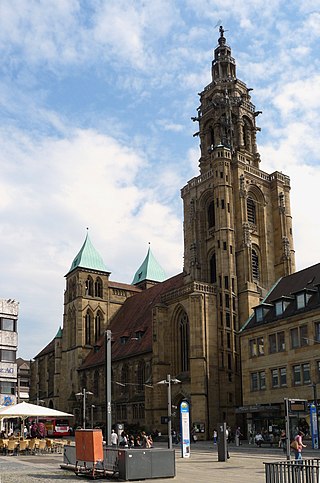
Kilian's Church on Kaiserstraße in Heilbronn is a Gothic hall church constructed from Heilbronner sandstone, whose origin dates back to the 11th century. Its western tower, constructed by Hans Schweiner, is one of the first major Renaissance buildings to be built north of the Alps. Inside the church there is an altar by Hans Seyffer from 1498, which is regarded as a masterpiece of sculpture from the Late German Gothic period. Some of the stained glass is by Charles Crodel. The Monument Foundation of Baden-Württemberg appointed the church as monument of the month in December 2016.

Würzburg is, after Nuremberg and Fürth, the third-largest city in Franconia located in the north of Bavaria. Würzburg is the administrative seat of the Regierungsbezirk Lower Franconia. It spans the banks of the Main river.

Divi Blasii is a Gothic church in the Thuringian town of Mühlhausen, central Germany. Besides St Mary's, it is one of Mühlhausen's two principal churches. Divi Blasii is a three-aisle, cruciform hall church, situated on the Untermarkt in the historical centre of the town. The elaborately designed display façade with tracery, pinnacles and a wheel window on the north side is located on an old trade route. Today, Divi Blasii is the central parish church of the Lutheran parish of Mühlhausen within the Protestant Church in Central Germany.

The Marienkirche, Würzburg is a chapel located in the inner court of Marienberg Fortress in Würzburg, Bavaria. The first Christian church at this location was built in 706 by Duke Hedan II. The structure of today's building can be traced back to the early 11th century. It is the oldest church in Würzburg and the oldest building in the fortress.
Ottogerd Ludwig Wilhelm Mühlmann was a German academic, art historian, notable for his work in historical preservation.

The Marienkapelle is a Roman Catholic church located at the Unterer Markt of the town of Würzburg, Bavaria. It was built in the Gothic style in the 14th century. Despite its large size, it is a chapel by status, as it does not have a parish. Today it is administered by the united parishes of the Würzburg Cathedral and the Kollegiatstift Neumünster.

The Protestant Church in Borgholzhausen, North Rhine-Westphalia, Germany, is the church of the Lutheran parish there, which belongs to the Halle district of the Evangelische Kirche von Westfalen. The building dates back to the 14th century. It features a unique carved stone altarpiece from 1501.
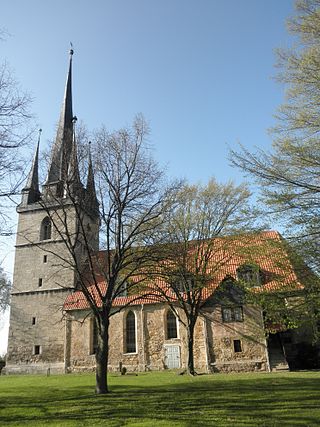
St Walpurgis' Church in the upper part of the village of Großengottern in Thuringia, Germany, is a Late Gothic church building dating from the 15th century. Today, it is a Lutheran parish church. St Walpurgis' Church is known for its large Baroque organ by the significant organ builder Tobias H. G. Trost.
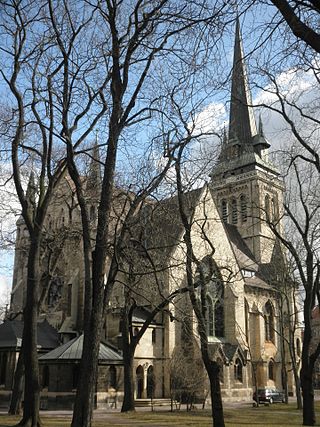
St Thomas' Church in the city of Erfurt in Thuringia, Germany, is a United Protestant parish church. It was built in Gothic Revival style in a park on Schillerstraße in the Löbervorstadt district in 1900–1902 to replace the Old St Thomas' Church, which had become too small. It has the second-highest steeple in the city at 72 metres (236 ft) and houses a Gothic altar retable from 1445, which is one of Erfurt's four valuable carved altars.








